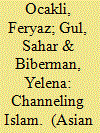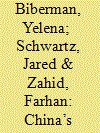|
|
|
Sort Order |
|
|
|
Items / Page
|
|
|
|
|
|
|
| Srl | Item |
| 1 |
ID:
148944


|
|
|
|
|
| Summary/Abstract |
Pakistan's religious television programs have drawn significant attention in both academic and policy circles. However, there has been surprisingly little systematic analysis of their content and influence. This article shows that, although the televangelists featured on the Pakistani television channels present some of the most conservative views regarding the role of women and religious minorities in society and the role of Islam in governance, Pakistani television is an arena of contestation. The impact of the lively debates between televangelists on young viewers—over whom the ideological battles are being waged—is mixed. Findings from an original survey of Pakistani students and political activists suggest that young people in Pakistan watch religious shows only occasionally. Those that do, however, take them seriously. What leads young people to consume religion on television is a sense of social responsibility: that they are doing it not just for themselves, but also—and perhaps more importantly—for others, be it their families or communities.
|
|
|
|
|
|
|
|
|
|
|
|
|
|
|
|
| 2 |
ID:
189446


|
|
|
|
|
| Summary/Abstract |
Over the past eight years, Beijing drastically furthered its interests with the China-Pakistan Economic Corridor (CPEC) while reducing terrorism threats from AfPak-based groups. All this despite the repression of Muslim minority Uyghurs in the Pakistan-bordering Xinjiang region. What has been China’s security strategy in Pakistan? What lessons are there for the United States? Drawing on fieldwork in China and Pakistan, as well as interviews with Chinese, Pakistani, and US officials, journalists, and local experts, this article shows that Beijing’s security strategy in Pakistan rests on four pillars: (1) military invisibility; (2) economic visibility; (3) indiscriminate diplomacy, and (4) geopolitical alignment. This is the opposite of what has been Washington’s approach, which can be characterized as militarily visible, economically invisible, diplomatically selective, and generally at odds with Pakistan’s regional interests.
|
|
|
|
|
|
|
|
|
|
|
|
|
|
|
|
| 3 |
ID:
168290


|
|
|
|
|
| Publication |
New Delhi, Oxford University Press, 2019.
|
| Description |
xv, 220p.hbk
|
| Standard Number |
9780190099800
|
|
|
|
|
|
|
|
|
|
|
|
Copies: C:1/I:0,R:0,Q:0
Circulation
| Accession# | Call# | Current Location | Status | Policy | Location |
| 059729 | 355.02/BIB 059729 | Main | On Shelf | General | |
|
|
|
|
| 4 |
ID:
160691


|
|
|
|
|
| Summary/Abstract |
Why did the Pakistani military carry out genocidal violence against East Pakistani Hindus during the 1971 civil war when the Hindus did not constitute a security threat? This question carries not only theoretical but also important policy and security implications in present-day Bangladesh. A uniquely in-depth analysis of the little-known genocide in East Pakistan in 1971 shows that genocidal violence may be used as an instrument of nation-building. It was designed to mobilize both the Pakistani troops and the Bengali Muslim population against a convenient, well-defined enemy. The logic of othering – and then exterminating – a religious minority was meant to integrate a defiant, and previously marginalized, group into a reimagined community.
|
|
|
|
|
|
|
|
|
|
|
|
|
|
|
|
| 5 |
ID:
155925


|
|
|
|
|
| Summary/Abstract |
This article explores public knowledge creation by examining how the New York Times produced Pakistan news between 1954 and 1971, the formative period of United States of America (USA)–Pakistan relations. These years encapsulate not only the heyday of cooperation between the two governments, but also the American public's first major introduction to the South Asian country by the increasingly intrepid news media. A leader in shaping that introduction was the New York Times. While most studies of the American media focus on measuring the effect of news exposure and content on public opinion, this article focuses on the theoretically underexplored aspect of news production: foreign news gathering. With a lens on South Asia, it shows that foreign news gathering involves the straddling of on-the-ground political and logistical constraints that generate an atmosphere of high uncertainty. By exploring the limitations on news gathering faced by America's leading newspaper's foreign correspondents in Pakistan in the 1950s and 1960s, this article identifies an important historical source of the ambiguity characterizing USA–Pakistan relations. The findings are based on recently released archival material that offers rare insight into the news-production process.
|
|
|
|
|
|
|
|
|
|
|
|
|
|
|
|
| 6 |
ID:
111021


|
|
|
|
|
| Publication |
2011.
|
| Summary/Abstract |
Yelena Biberman discusses the causes and implications of the diplomatic drain since the early 1990s-inside the Russian Ministry of Foreign Affairs. Drawing on an original survey of students at academic programs in elite Russian universities designed to train diplomats, she challenges the idea that inadequate material benefits limit interest in Russian diplomatic careers. Instead, she demonstrates that concerns over the relative power and prestige of the diplomatic corps guide prospective diplomats in their career choices.
|
|
|
|
|
|
|
|
|
|
|
|
|
|
|
|
| 7 |
ID:
160030


|
|
|
|
|
| Summary/Abstract |
What explains the variation in states’ nonstate partners in civil warfare? States often use nonstate actors to do what their regular military forces cannot do well – navigate the local population. Some of their nonstate partners are ordinary civilians, while others are battle-hardened fighters with a rebellious or criminal past. The choice of proxy carries serious implications for the patterns and effects of violence during civil war, human rights, and international security. This article is the first to disaggregate the nonstate counterinsurgents and offer an explanation for why and how states use each type. It brings together the politics of collaboration with the politics of exploitation. The article shows that the state’s use of nonstate proxies is shaped by the supply of willing collaborators, the state’s ability to exercise control over them, and the trade-offs underlying the use of the different types of nonstate actors. The empirical evidence used to support this argument comes from a novel, comparative study of Turkey’s counterinsurgency campaign against Kurdish separatists and India’s counterinsurgency against Kashmiri separatists. The original data were collected through fieldwork in the disputed territories of each country.
|
|
|
|
|
|
|
|
|
|
|
|
|
|
|
|
| 8 |
ID:
163359


|
|
|
|
|
| Summary/Abstract |
MANY GROUPS ASPIRE TO GOVERN TERRITORY, but few actually followed through with it to the extent that the Islamic State in Iraq and Syria (ISIS) had. In addition to the brutal executions and disfigurements, ISIS also came to be known for fixing potholes, installing power lines, administering polio vaccines, and establishing schools, post offices, roving police forces, food kitchens, and even a consumer protection bureau.
Welfare was an important component of ISIS's “stateness”2 and was widely viewed as a means by which the organization targeted the hearts and minds of the local population. However, not all militias with territorial aspirations provide public goods. Tehrik‐e‐Taliban Pakistan (TTP) is a case in point. The TTP is the largest jihadi group operating in Pakistan, with the ultimate goal of installing a caliphate. While active mainly in a region where state provision of social services is poorest, the TTP has shown little regard for its inhabitants’ welfare. Surprisingly little of the militia's inordinate wealth has been allotted to taking care of the local population. Why do some militias provide welfare while others do not?
|
|
|
|
|
|
|
|
|
|
|
|
|
|
|
|
| 9 |
ID:
166657


|
|
|
|
|
| Summary/Abstract |
Why do terrorists engage in behavior that is extreme even by their own admission—killing children? This behavior poses a major puzzle to our understanding of terrorism, but it has been surprisingly underexplored. This article addresses the question of why terrorists intentionally target children with a comparative study of the two deadliest attacks in which children were deliberately targeted by a militant organization: the Peshawar (2014) and Beslan (2004) school massacres. The article identifies two factors that increase the likelihood that a terrorist group will target children. The first is the presence of internal rifts within an already highly violent organization. This is likely to trigger outbidding and, thus, result in more brutal attacks. The second is existentially threatening external pressure, which seriously weakens the group and, thus, leads it to select soft and shocking targets, such as schools. The findings are based on evidence drawn from primary and secondary sources, including interviews conducted in Peshawar and Islamabad, Pakistan, and Moscow, Russia.
|
|
|
|
|
|
|
|
|
|
|
|
|
|
|
|
|
|
|
|
|